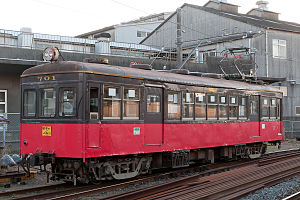- Choshi Electric Railway 700 series
-
Choshi Electric Railway 700 series 
DeHa 701 at Nakanocho Depot, January 2010In service 1978–2010 Constructed 1942 Number built 2 vehicles Number in service 0 Formation Single car Fleet numbers DeHa 701/702 Capacity 110 (42 seated) Operator Choshi Electric Railway Depot(s) Nakanocho Specifications Car body construction Steel Car length 15,365 mm Width 2,743 mm Doors 2 per side Weight 26 t Traction system SE-199C (52 kW x2) Power output 104 kW Electric system(s) 600 V DC Current collection method Overhead wire Bogies Sumitomo KS-33S Gauge 1,067 mm (3 ft 6 in) The Choshi Electric Railway 700 series (銚子電鉄700形 Chōshi Dentetsu 700-gata) was an electric multiple unit train type operated by the Choshi Electric Railway in Japan between 1978 and 2010. Two single cars were converted from former Ohmi Railway MoHa 50 EMU cars, which were built in 1942.[1]
Contents
Build details
No. Former No. Build date Withdrawal date DeHa 701 MoHa 51 1942 September 2010 DeHa 702 MoHa 52 1942 January 2010 Source: [1]
Interior
The trains featured longitudinal seating, and were not air-conditioned. DeHa 701 was equipped with fare collection boxes at each end for wanman driver only operation.[1]
History
Two 1942-vintage MoHa 50 EMU cars were purchased from Ohmi Railway, and were modified at Seibu Railway's workshops in Tokorozawa, Saitama in 1978, becoming DeHa 701 and DeHa 702. The MoHa 50 EMU cars themselves used the bogies and electrical equipment from former wooden-bodied DeYuWa 101 and 102 freight EMU cars built in March 1928. The MoHa 50 cars were originally built as single-cars, but had one cab end removed in 1961. The second cab ends were reinstated on conversion for use on the Choshi Electric Railway.[1]
In September 1990, both cars were repainted into the new standard livery of dark brown and red. DeHa 701 was repainted into a promotional yellow livery in June 1994, and modified for driver only operation in December 1994.[1]
In June 1995, DeHa 701 was involved in a head-on collision north of Kasagami-Kurohae Station when it hit DeHa 1001 on an up (Chōshi-bound) service. Both cars sustained front-end damage. DeHa 701 was returned to service in April 1996 following repairs and repainting back into the new standard livery of dark brown and red.[1]
In November 2007, DeHa 702 was repainted into the 1950s livery of sky blue and pale grey. This car was not modified for driver only operation, and was thus limited to use as a second car to lengthen busier services or for tour groups. It was withdrawn from service in January 2010, and DeHa 701 was withdrawn after its final day of operation on 23 September 2010.[2]
See also
 Media related to Choshi Electric Railway 700 series at Wikimedia Commons
Media related to Choshi Electric Railway 700 series at Wikimedia Commons
References
- ^ a b c d e f Satō, Toshio (December 2009). "銚子電鉄の電車たちを訪ねて [Visiting the trains of the Chōshi Electric Railway]" (in Japanese). Japan Railfan Magazine (Japan: Kōyūsha Co., Ltd.) 49 (584): p.92–96.
- ^ "銚子電気鉄道デハ701・デハ801が引退 [Choshi Electric Railway DeHa701 & DeHa 801 Withdrawn]" (in Japanese). RM News. Neko Publishing. 24 September 2010. http://rail.hobidas.com/rmn/archives/2010/09/701801.html. Retrieved 25 September 2010.
External links
Chōshi Electric Railway rolling stock In service Withdrawn 100 series • 200 series • 300 series • 500 series • 700 series • 800 seriesCategories:- Electric multiple units of Japan
- 1978 introductions
Wikimedia Foundation. 2010.





